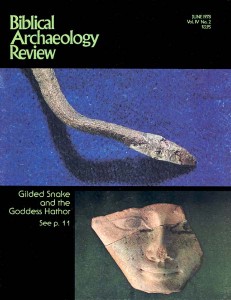Biblical Archaeology Review, June 1978
Features
Were the Early Israelites Pastoral Nomads?
A Biblical sociologist looks at the patriarchs and Exodus Israelites
The Bible relates that early Israel entered Canaan twice—once in the Patriarchal Age and a second time after the Exodus from Egypt. Prior to 1960 virtually all commentators on Israelite origins pictured early Israel as a pastoral nomadic people who penetrated Canaan from the desert, and who,...Read more ›
The Mystery of the Horses of the Sun at the Temple Entrance
Kathleen Kenyon's discovery in cult center illuminates puzzling Biblical passage
The last great Yahwistic religious reform before the fall of Jerusalem in 586 B.C. was carried out in Judah by King Josiah in about 621 B.C. The Bible tells us that Josiah “did what was right in the eyes of the Lord, following in the footsteps of...Read more ›
Estimating the Population of Ancient Jerusalem
Archaeology provides a new more accurate method for estimating ancient populations. Davidic Jerusalem was home to fewer than 2000 people.
Despite its obvious importance, the number of ancient Jerusalem’s inhabitants is a subject that is often ignored. Until recently, writers who did deal with the matter based their estimates on ancient literary sources, which, however, are generally considered to be untrustworthy.1 Even Josephus, the first century Jewish...Read more ›
“From These Hills … ”
Midianite tent shrine found amidst ancient Negev copper mines. Recent excavations lead to new understanding of ancient mining technology; no evidence of King Solomon.
For almost two decades and still continuing, Israeli archaeologist Beno Rothenberg has investigated the Timna Valley—called in Arabic wadi Mene’iyeh and known to thousands of visitors as “King Solomon’s Mines”. At first Rothenberg came almost alone to this isolated spot in the Negev about 20 miles north...Read more ›
The Double Paternity of Jesus
Dual fatherhood, human and divine, was not uncommon in ancient times. Kingship was transmitted through the human husband of the mother.
The two variant genealogies of Jesus in Matthew 1:1–16 and Luke 3:23–38 agree on the essential point that he was descended from King David through Joseph, the husband of Mary. To be the legitimate King of the Jews, Jesus had to...Read more ›
"Your Journal Is Not to My Taste"
Prominent Israeli archaeologist blasts BAR, asks to be left alone
In the June 1977 issue of the BAR you initiated a crusade against excavators who withhold information and photographs of unpublished finds to the press (“Tight-Lipped Archaeologists—How the Press Erred,” BAR 03:02). For some reason you chose me as the main target for your attack. In the...Read more ›
Is Withholding Pictures of Archaeological Finds Justifiable?
BAR lauds Avigad's scholarship but finds his refusal to release pictures indefensible
We are delighted to report that Professor Nachman Avigad has published in a recent issue of the Israel Exploration Journal a report and picture of the “Justinian” inscription which he found in the Old City of Jerusalem. Professor Avigad’s article in that distinguished scholarly journal is entitled...Read more ›
Digging the Talmud in Ancient Meiron
The Talmud is, after the Bible itself, Judaism’s most significant and revered collection of sacred writings. Although the Talmud was in fact written and compiled between the Second and Fifth centuries A.D., rabbinic tradition holds that it was given to Moses at Mount Sinai together with the...Read more ›

